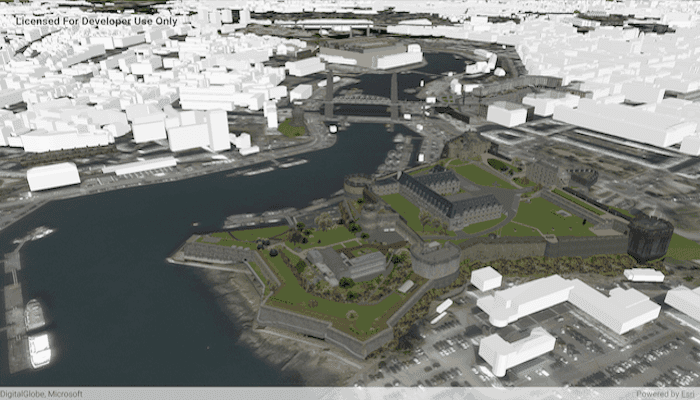Add a scene layer to a scene.

Use case
Each scene layer added to a scene can assist in performing helpful visual analysis. For example, if presenting the results of a shadow analysis of a major metropolitan downtown area in 3D, adding a scene layer of 3D buildings to the scene that could be toggled on/off would help to better contextualize the source of the shadows.
How to use the sample
When launched, this sample displays a scene service with an ArcGISSceneLayer. Pan and zoom to explore the scene.
How it works
- Create an
ArcGISSceneand set itsBasemapwithArcGISScene.basemap. - Create a
SceneViewand set the scene to the view withSceneView.scene. - Create an
ArcGISSceneLayerusing a data source URI:ArcGISSceneLayer(Uri). - Add the new scene layer to the scene as an operational layer with
ArcGISScene.operationalLayers.add(sceneLayer).
About the data
The scene launches with a northward view of the city of Brest, France. A 3D scene layer representing buildings (some textured) is used as an example.
Relevant API
- ArcGISScene
- ArcGISSceneLayer
- SceneView
Tags
3D, layer, scene
Sample Code
/*
* Copyright 2020 Esri
*
* Licensed under the Apache License, Version 2.0 (the "License");
* you may not use this file except in compliance with the License.
* You may obtain a copy of the License at
*
* http://www.apache.org/licenses/LICENSE-2.0
*
* Unless required by applicable law or agreed to in writing, software
* distributed under the License is distributed on an "AS IS" BASIS,
* WITHOUT WARRANTIES OR CONDITIONS OF ANY KIND, either express or implied.
* See the License for the specific language governing permissions and
* limitations under the License.
*
*/
package com.esri.arcgisruntime.sample.scenelayer
import android.os.Bundle
import androidx.appcompat.app.AppCompatActivity
import com.esri.arcgisruntime.ArcGISRuntimeEnvironment
import com.esri.arcgisruntime.layers.ArcGISSceneLayer
import com.esri.arcgisruntime.mapping.ArcGISScene
import com.esri.arcgisruntime.mapping.BasemapStyle
import com.esri.arcgisruntime.mapping.view.Camera
import com.esri.arcgisruntime.mapping.view.SceneView
import com.esri.arcgisruntime.sample.scenelayer.databinding.ActivityMainBinding
class MainActivity : AppCompatActivity() {
private val activityMainBinding by lazy {
ActivityMainBinding.inflate(layoutInflater)
}
private val sceneView: SceneView by lazy {
activityMainBinding.sceneView
}
override fun onCreate(savedInstanceState: Bundle?) {
super.onCreate(savedInstanceState)
setContentView(activityMainBinding.root)
// authentication with an API key or named user is required to access basemaps and other
// location services
ArcGISRuntimeEnvironment.setApiKey(BuildConfig.API_KEY)
// create a scene layer from a url
val sceneLayer = ArcGISSceneLayer(getString(R.string.brest_buildings))
// create a camera with initial camera position
val camera = Camera(48.378, -4.494, 200.0, 345.0, 65.0, 0.0)
// create a scene
val brestBuildingScene = ArcGISScene(BasemapStyle.ARCGIS_TOPOGRAPHIC).apply {
// add a scene service to the scene for viewing buildings
operationalLayers.add(sceneLayer)
}
// create a scene view
sceneView.apply {
// add the scene to the scene view
scene = brestBuildingScene
// set initial camera position
setViewpointCamera(camera)
}
}
override fun onPause() {
super.onPause()
sceneView.pause()
}
override fun onResume() {
sceneView.resume()
super.onResume()
}
override fun onDestroy() {
super.onDestroy()
sceneView.dispose()
}
}